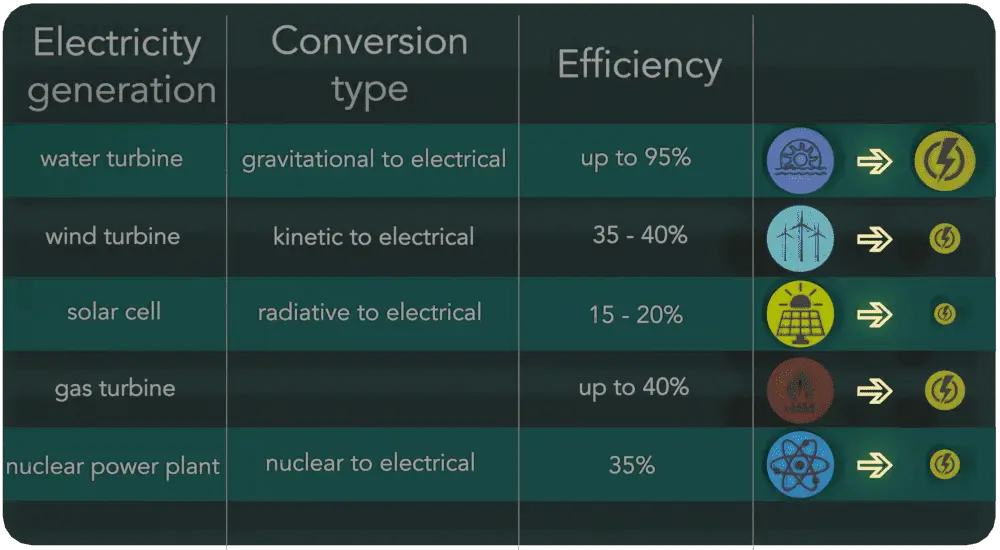Energy conversion and storage efficiency
Energy exists in many forms. All energy conversions are associated with significant energy losses.
It is desirable to minimize the number of energy conversions and to use only efficient conversions.
Daily energy storage does not pose a problem. The problem is energy storage to cover the whole year and seasons.
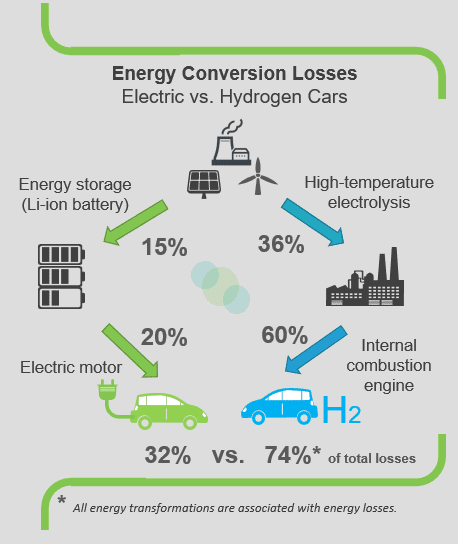
In this article, we will briefly describe why transforming energy is not beneficial and why storing large amounts of energy is very difficult.
Energy exists in many forms. Common energy forms include mechanical, thermal, or chemical energy. One of the most wonderful properties of the universe is that energy can be transformed from one type to another and transferred from one object to another. Humans have created various energy conversion devices for these purposes. These devices are, for example:
- Heat engines, such as the internal combustion engine used in cars, or the steam engine (Heat → Mechanical energy)
- Electric generator (Kinetic energy or Mechanical work → Electrical energy)
- Electric motor (Electrical energy → Mechanical work)
- Battery (electricity) (Chemical energy → Electrical energy)
- Electric heater (Electric energy → Heat)
- Fire (Chemical energy → Heat and Light)
For example, burning gasoline to power cars is an energy conversion process we rely on. The chemical energy in gasoline is converted to thermal energy, then converted to mechanical energy that makes the car move. The mechanical energy has been converted to kinetic energy. When we use the brakes to stop a car, that kinetic energy is converted by friction back to heat or thermal energy.
But nothing is perfect. One Joule in thermal energy is not the same as one Joule in kinetic energy. All these energy conversions are associated with energy losses. For example, a typical gasoline automotive engine operates at around 25% to 30% of thermal efficiency. About 70-75% is rejected as waste heat without being converted into useful work, i.e., work delivered to wheels. This inefficiency is caused predominantly by the Second law of thermodynamics.
If not necessary, we want to say that the transformation of energies is always associated with losses. For example, compare CNG and hydrogen-powered vehicles with an internal combustion engine. Note that most hydrogen (∼95%) is produced from fossil fuels by steam reforming of natural gas with the efficiency of process about 65% to 75%. In the case of hydrogen-powered vehicles, you must multiply inefficiencies associated with natural gas-to-hydrogen conversion (about 0.7) since the other inefficiencies are similar. The solution, of course, is to produce hydrogen using renewable or sustainable sources.
The efficiency of electricity generation
Electricity is not freely available in nature, so it must be “produced” (transforming other forms of energy into electricity). Production is carried out in power plants. Electricity is often generated at a power plant by electromechanical generators, primarily driven by heat engines. A heat engine is a device that converts chemical energy to heat or thermal energy and then to mechanical energy or electrical energy. The problem with chemical energy is that we cannot directly convert chemical energy into electrical energy, but we must first convert (by combustion) it into thermal energy. The thermal efficiency of heat engines is limited by the laws of thermodynamics and is generally low.
Wind turbines are limited by Betz’s law, which indicates the maximum power that can be extracted from the wind. According to Betz’s law, no turbine can capture more than 16/27 (59.3%) of the kinetic energy in the wind. The factor 16/27 (0.593) is known as Betz’s coefficient.
Solar cell efficiencies vary from 6% for amorphous silicon-based solar cells to 44.0% with multiple-junction production cells and 44.4% with multiple dies assembled into a hybrid package. Solar cell energy conversion efficiencies for commercially available multi-crystalline Si solar cells are around 14–19%.
Large modern water turbines operate at mechanical efficiencies greater than 90%.
Efficiency of motors
The efficiency of an electric motor is significantly higher than the efficiency of a combustion engine. In the case of an electric motor, however, it is necessary to consider from which sources the electricity is produced.
Energy storage
Energy storage is probably the biggest challenge of transitioning to a low-carbon economy. You may be wondering how we store energy today. The answer is simple. Fossil fuels such as coal and gasoline store ancient energy derived from sunlight by organisms that later died and became buried and, over time, were then converted into these fuels. The energy of fossil fuels can be stored simply in gas, oil, and coal storage in large quantities. Such a dimension of production and storage needs to be built for the transition to a low-carbon economy. Therefore, it is necessary to divide energy storage into:
- Grid energy storage. Generation and consumption of electricity must be balanced across the entire grid because energy is consumed as it is produced. Electrical energy is stored during times when electricity is plentiful and inexpensive (especially from intermittent power sources such as renewable electricity from wind power, tidal power, and solar power) or when demand is low and later returned to the grid when demand is high, and electricity prices tend to be higher. Pumped storage hydroelectricity accounts for more than 99% of bulk storage capacity worldwide. Lithium batteries show the largest market growth of all other batteries and have successfully displaced the competing systems.
- Long-term seasonal storage. For most countries, the highest energy consumption is in autumn and winter, when there is little wind inland and little Sun. The only promising seasonal energy storage technology is known as Power-to-gas (often abbreviated P2G), and most P2G systems use electrolysis to produce hydrogen.
Characteristics of variable renewables include their unpredictability, variability, low running costs, and the fact that they are constrained to a certain location. These challenge grid operators must ensure supply and demand are matched. Solutions include energy storage, demand response, availability of overcapacity, and sector coupling. The higher the share of these sources in the energy mix, the higher the transmission and energy storage system’s demands. Without sufficient energy storage capacity, there may be power outages, and there will certainly be seasonal fluctuations in electricity prices.
In this section, a short summary of each storage technology is provided. The technologies are categorized according to the type of energy the technology stores, and examples of applications are provided. The types of energy storage technologies are as follows:
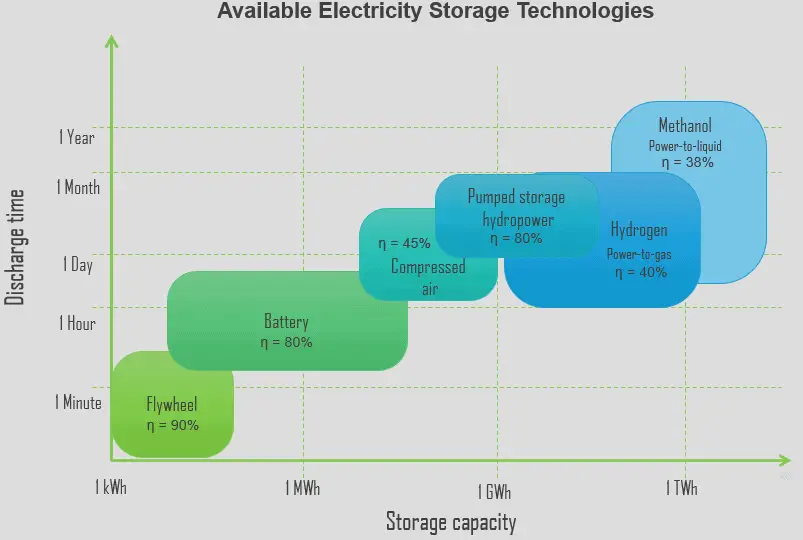 Mechanical energy
Mechanical energy
- Pumped Hydro Energy Storage. Pumped storage hydroelectricity accounts for more than 99% of bulk storage capacity worldwide, representing around 127,000 MW. PSH energy efficiency varies in practice between 70% and 80%. Hydro plants need a consistent supply of water and a large amount of land. Some countries have plenty of these resources; others do not.
- Compressed Air Energy Storage. In CAES facilities, the air is compressed and stored under high pressure in underground caverns. CAES is an alternative to pumped hydro since it has relatively high power output and storage capacity. Compressing and decompressing air introduces energy losses, resulting in only 40-50% electric-to-electric efficiency.
- Flywheels. A flywheel energy storage system has many advantages, for it runs in a high-vacuum environment and has no friction loss, small wind resistance, a cycle efficiency of 85%–95%, has a long life, and is eco-friendly and free of maintenance. Flywheels are not suitable for long-term energy storage like batteries.
- Electrochemical energy
- Lithium-Ion Batteries. Lithium batteries show the largest market growth of all other batteries and have successfully displaced the competing systems. Lithium-ion batteries, unlike conventional batteries, do not have a memory effect (loss of capacity by not completing loading/unloading) and achieve high efficiency of up to 95% (ratio of discharge to charge amount). The problem with these batteries is their lifespan, typically defined as the number of full charge-discharge cycles to reach a failure threshold in terms of capacity loss or impedance rise.
- Flow Batteries. The biggest advantages of flow batteries are the capability to pack in large volumes. Flow batteries have relatively low energy densities and have long life cycles, which makes them well-suited for supplying continuous power.
- Sodium-Sulfur Batteries
- Long-term chemical energy storage
- Power-to-gas. Power-to-gas (often abbreviated P2G) is a technology that converts electricity to gaseous fuel (e.g., hydrogen). Currently, this is the only promising seasonal energy storage technology. Moreover, P2G can help the intermittent production of energy by renewables to be evened out throughout the year by providing them a controllable power load, enabling them to have a bigger energy share. The round-trip efficiency of power-to-gas storage was well below 50%, with the hydrogen path reaching maximum efficiency of ~ 43% and methane of ~ 39% by using combined-cycle powerplants.
- Power-to-liquid
- Thermal energy
The efficiency of energy storage
Appropriate energy storage capacity is one thing, though energy storage is not without losses either, as the following table shows.
Why is energy storage so difficult?
Nowadays, energy storage seems simple. For example, many companies offer photovoltaic systems along with battery storage. Energy storage to cover daily consumption has an expensive but easy solution. However, the problem is energy storage to cover the whole year and seasons. For most countries, the highest energy consumption is in autumn and winter, when there is little wind inland and little Sun. Consider, for example, a small residential home that consumes about 3,000 kWh of electricity annually and about 15,000 kWh of natural gas for space heating.
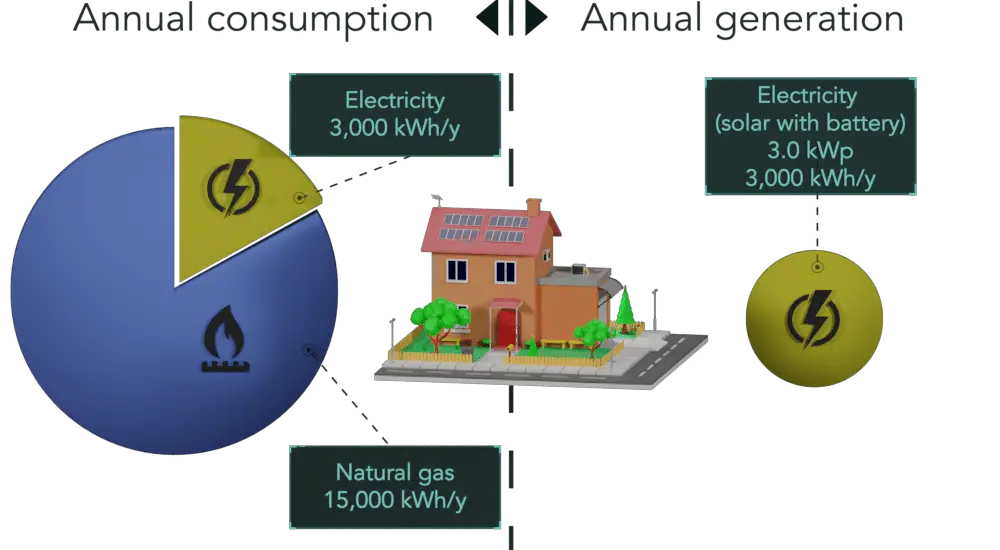
Note that more than half (51% in 2015) of a household’s annual energy consumption is for just two energy end uses: space heating and air conditioning. These seasonal and energy-intensive uses vary significantly by geographic location, home size, structure, equipment, and the fuel used. Residential homes consume about 91 kWh (3,000/365 + 15,000/180) energy per winter day.
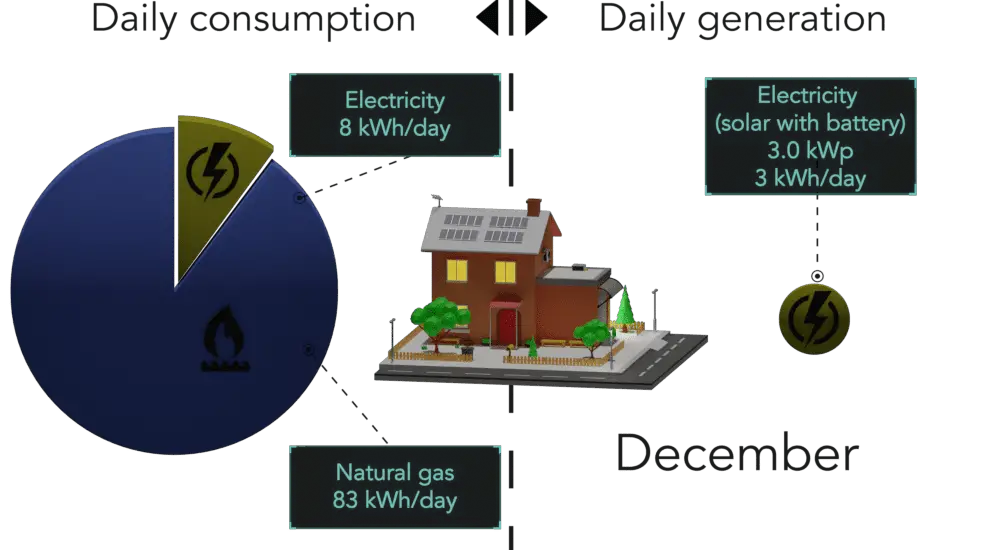
As you can see, space heating dominates in winter. This would require a large overcapacity of solar power; otherwise, these residential homes need to be connected to an external energy source. Energy storage technologies based on batteries are not sufficient for this purpose. The only promising seasonal energy storage technology is known as Power-to-gas (often abbreviated as P2G). Most P2G systems use electrolysis to produce hydrogen. The hydrogen can be used directly, or further steps (known as two-stage P2G systems) may convert the hydrogen into syngas, methane, or LPG. Power-to-gas systems may be deployed as adjuncts to wind parks or solar-electric generation. The excess power or off-peak power generated by wind generators or solar arrays may then be used hours, days, or months later to produce electrical power for the electrical grid. Power-to-gas allows energy from electricity to be stored and transported in the form of compressed gas, often using existing infrastructure for long-term transport and storage of natural gas. In 2013, the round-trip efficiency of power-to-gas storage was well below 50%, with the hydrogen path reaching maximum efficiency of ~ 43% and methane of ~ 39% using combined-cycle powerplants. The technology is being developed, but the other issue is the price for energy storage of the necessary capacity.
